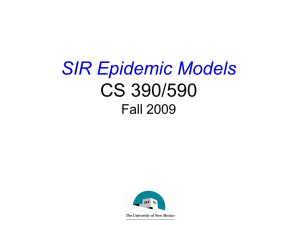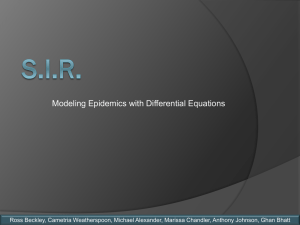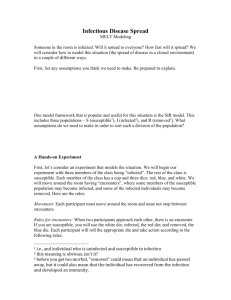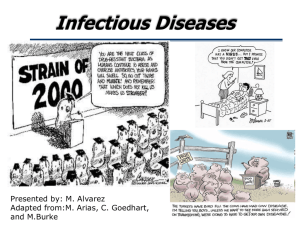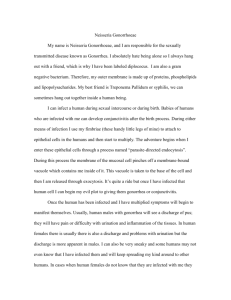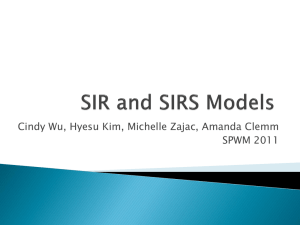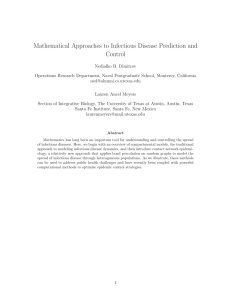Notes
advertisement
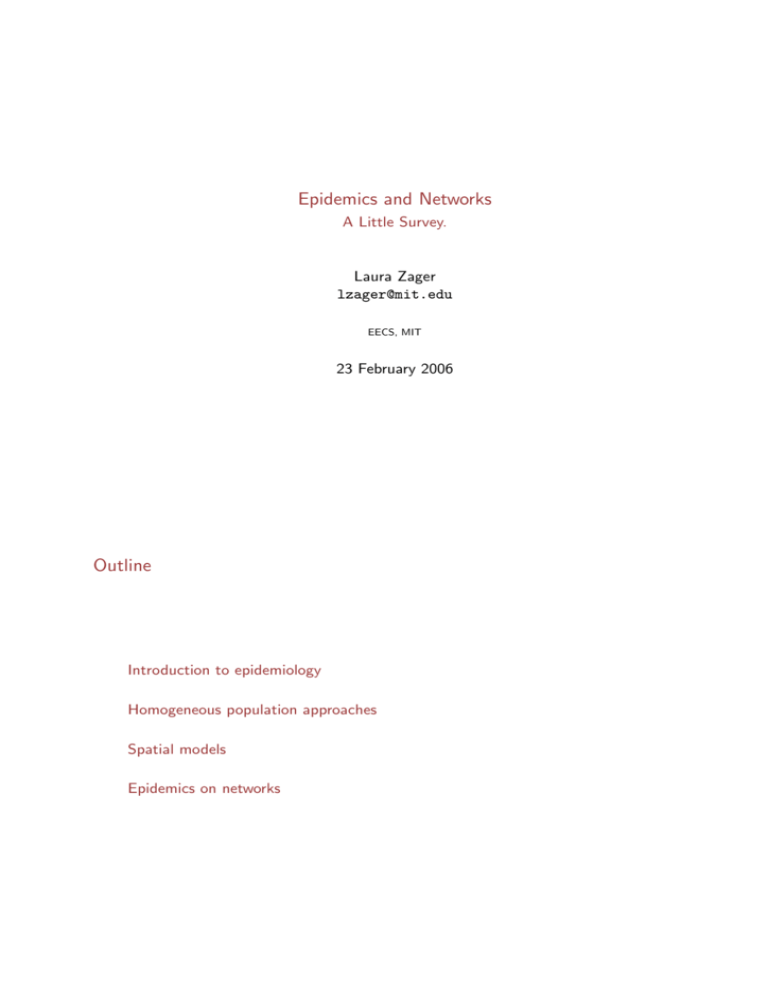
Epidemics and Networks A Little Survey. Laura Zager lzager@mit.edu EECS, MIT 23 February 2006 Outline Introduction to epidemiology Homogeneous population approaches Spatial models Epidemics on networks Early history John Graunt, 1620-1674 ◮ Natural and Political Observations made upon the Bills of Mortality, 1662. ◮ one of the earliest examples of statistical demography. Bills of Mortality for London, August 15-22, 1665 http://eee.uci.edu/clients/bjbecker/PlaguesandPeople/lecture7.html Early history Daniel Bernoulli, 1700-1782 ◮ Essai d’une nouvelle analyse de la mortalité causée par la petite vérole et des avantages de l’inoculation pour la prévenir, 1760 ◮ presented a differential equations model of smallpox population dynamics William Farr, 1807-1883 ◮ Second report of the Registrar-General of England and Wales, 1840. ◮ fitted curves to outbreak data on smallpox and rinderpest in cattle Bernoulli http://www.mathematik.ch/mathematiker/daniel bernoulli.php Farr http://www.york.ac.uk/depts/maths/histstat/people/farr.gif Infectious disease progression The 19th century’s key idea: a disease is transmitted from an ill individual to a healthy individual via an infectious microbe. susceptible susceptible susceptible latent latent latent infectious with symptoms infectious asymptomatic infectious with symptoms removed removed infectious asymptomatic infectious with symptoms infectious asymptomatic removed Example SIS model - appropriate for diseases that don’t confer immunity or death, e.g. the common cold. Measurements Population disease parameters incidence rate frequency of occurrence of some event per individual during a period of time. prevalence rate proportion of population affected by a disease at a given time. mortality rate number of deaths per individual per unit of time. Combined influenza and pneumonia mortality curve, UK, 1918-1919. from Taubenberger, CID 2006 HIV prevalence curve in southern Africa, by nation, 2001-2005 from UNAIDS/WHO Aids Epidemic Update 2005 What is an epidemic? An epidemic is “any marked upward fluctuation in disease incidence or prevalence” [Barker, 1973]. For SIS or SIRS models: ◮ is there a non-zero fraction of infected individuals in the long term? For SIR models: ◮ does the population of infectives increase from its initial size? Model predictions and control Questions you’d like your model to answer... ◮ Will the disease become an epidemic? ◮ What percentage of the population will be affected? What percentage will die? ◮ How long will the disease persist? ...and consequent public health decisions. ◮ What kinds of policies might inhibit disease transmission? ◮ Can a vaccination campaign prevent an epidemic? What kind of vaccination strategy should we use? ◮ Is quarantining necessary, or will more mild social regulations be just as effective? ◮ Are there preventative measures that will make an epidemic unlikely? Law of mass action “If the individuals in a population mix homogeneously, the rate of interaction between two different subsets of the population is proportional to the product of the numbers in each of the subsets concerned.” [Daley & Gani, 1999] ◮ predicts that the rate at which the susceptible population becomes infected is proportional to the product of the sizes of the two populations. ◮ occurs in both deterministic and stochastic models of infection. Example ◮ Kermack & McKendrick, 1927 ◮ ◮ a continuous-time deterministic SIR ODE model. Whittle, 1955 ◮ a SIR Markov process model. Kermack & McKendrick, 1927 s the fraction of susceptible individuals in a population. i the fraction of infected individuals. r the fraction of removed individuals. β the contact rate of susceptible and infected individuals. γ the removal rate of infected individuals. γ ρ = β the relative removal rate. ds dt di dt dr dt = −βsi = βsi − γi = γi Theorem ◮ An epidemic occurs if and only if the initial fraction of susceptibles s0 exceeds the relative removal rate: β s0 > ρ ←→ R0 s0 ≡ s0 > 1 γ A digression on R0 The basic reproductive ratio ◮ defined as “the average number of secondary cases caused by an infectious individual in a totally susceptible population” [Keeling, 2001]. ◮ the initial rate of increase of a disease. R0 s0 > 1 AIDS smallpox measles malaria 2−5 3−5 16 − 18 > 100 Ranges of R0 for some well-known diseases from Keeling, Plus Mag., 2001. Example If there existed a vaccine for malaria (R0 = 100), then the fraction of the population that must be vaccinated to prevent an epidemic outbreak would be: 1− 1 = 0.99 R0 Whittle, 1955 j + 1, k − 1 β(j + 1)(k − 1) ◮ ◮ a continuous-time Markov SIR model. in state (s, i) = (j, k) and in the interval (t, t + δt): ◮ infections occur at rate βjkδt ◮ removals occur at rate γkδt. −γj − βjk j, k γ(k + 1) j, k + 1 Theorem Given a large susceptible population, if γ = ρ ≥ s0 β there is zero probability of the disease infecting a finite percentage of the susceptible population. Spatial approaches Discrete space Continuous space ◮ PDE models - diffusion dynamics. ◮ ◮ traveling epidemic waves, chaotic dynamic behavior. lattice percolation models, contact processes and voter models. ◮ often analyzed via simulations. Example ◮ Kendall, 1957 ◮ ◮ SIR model in continuous time and space. Rhodes & Anderson, 1997 ◮ simulations of a SIR model on a lattice with individual movement in discrete time. Spatial (and network) model analysis often employs mean-field approximations, in which local correlations are neglected. Kendall, 1957 ◮ ◮ ◮ an infinite, uniform 2D population with σ individuals per unit area. define s(P, t) (resp. i(P, t),r (P, t)) to be the susceptible (resp. infected, removed) proportions of the population in an infinitesimal area dA around a point P. define ĩ(P) to be a spatially-weighted average of i with respect to P. ∂s (P, t) ∂t ∂i (P, t) ∂t ∂r (P, t) ∂t = −βσs ĩ = βσs ĩ − γi = γi Theorem For an initial proportion of infectious individuals centered at the origin, and assuming some additional restrictions, the proportion of individuals contracting the disease will be larger than zero if and only if γ σ>ρ= β . Rhodes & Anderson, 1997 A SIRS model on a 2D toroidal lattice ◮ ◮ ◮ ◮ ◮ L × L lattice with population density σ. at each time step, an individual chooses one of his four neighboring nodes and moves there if it is unoccupied. a susceptible becomes infected with probability p by each of his infected neighbors, independently. an infected recovers with probability pr at each time step. Simulations indicate the existence of a threshold in σ, above which a non-zero fraction of the population is infected at steady state. a recovered individual becomes susceptible again with probability ps at each time step. Network preliminaries Graph terminology Recall: ◮ the adjacency matrix of a network of n nodes is the n × n matrix A defined by [A]ij = ◮ 1 0 (i, j) is an edge otherwise the degree of a node in an undirected graph is the number of edges adjacent to that node. Network parameters degree distribution P(k) is the probability that a node in the network has degree k. path length L is the number of edges in the shortest path between two vertices, averaged over all vertex pairs. clustering coefficient C is the average node clustering coefficient, Cv , where Cv is the fraction of possible edges between neighbors of node v that actually exist in the graph. Small-world networks - Watts & Strogatz, 1998 ◮ the rewiring model: for each vertex and each adjacent edge, rewire the other end of the edge to any other vertex with probability p. ◮ demonstrates both high clustering and short path lengths. In general, the small-world designation refers to a network’s clustering and path length properties, but does not imply a degree distribution! (e.g., the degree distribution of the Watts-Strogatz model has an exponential tail.) Degree distributions Exponential network ◮ the degree distribution is tightly clustered about its mean, and then falls away exponentially. ◮ a feature of classical Erdös-Rènyi random graphs (a Poisson distribution). Power-law (scale-free) distributions ◮ occurs when the degree distribution, P(k) ∼ k −ν , plotted on a log-log scale, is a straight line. ◮ described as having a fat tail - distribution is skewed with few nodes of very high degree. ◮ can be obtained through many different mechanisms. Sample exponential and power law networks. from Albert et. al, Nature, 2000. Frequency of populations of cities in the U.S., 2000 (plotted on linear and log scales). from Newman, Contemp. Phys., 2005. A highlight of some network epidemic models Example ◮ Pastor-Satorras & Vespignani, 2001/2002 ◮ continuous-time SIS model on infinite, undirected exponential and scale-free networks. ◮ Wang et al. & Ganesh et al., 2005 ◮ Markovian SIS models applied to arbitrary networks. Watts, et al., 2005 ◮ a stochastic SIR model operating on a metapopulation. Student social network, with clustering along racial and age group divisions. from Moody, American Journal of Sociology, 2001. ◮ Map of the Moscow subway system. from http://www.mosmetro.ru. Pastor-Satorras & Vespignani, 2001/2002 The network SIS model For a network with an infinite number of nodes and degree distribution P(k): ◮ a susceptible node is infected by each of its neighboring infectious nodes with probability β0 . ◮ an infected node becomes susceptible again with probability γ. Using a mean-field differential equations approach, when will the infection persist in the network and when will it die away? Pastor-Satorras & Vespignani, 2001/2002 Exponential networks ◮ since the degree distribution is clustered around its mean, k̄, assume that all nodes have degree k̄. ◮ let i(t), s(t) denote the expected density of infected, susceptible nodes at time t: di(t) = β0 k̄i(t)s(t) − γi(t) dt ◮ observe that this model is identical to the homogeneous deterministic model that we started with, with the infectivity parameter β now equal to β0 k̄. Results When β0 k̄ s γ 0 > 1, the network will reach a steady state in which i(t) > 0. (recall that the deterministic model exhibited a threshold at β s > 1, where β a per-proportion rate) γ 0 Pastor-Satorras & Vespignani, 2001/2002 Power-law degree distribution ◮ ◮ since P(k) ∼ k −ν is highly skewed, can no longer assume that each node has roughly the same degree. Results ◮ for 2 < ν ≤ 3, the network will reach a steady state in which i(t) > 0 for every set of parameter values! ◮ for 3 < ν, the infection will be endemic in the network if and only if define: ◮ m - the minimum degree of the nodes in the network. ◮ i (t) - the fraction of degree-k nodes which are k infected ◮ Θ(i(t)) - the probability that any given link points to an infected node. dik (t) = β0 ksk (t)Θ(i(t)) − γik (t) dt ν−1 β0 > γ mν May & Lloyd, 2002 present an SIR model with infection parameter β0 and recovery parameter γ and find that the fraction of the network ever infected has the same threshold behavior as Pastor-Satorras & Vespignani’s model! Wang et al. & Ganesh et al., 2005 Wang et al., 2005 - a discrete time model Consider an arbitrary network with adjacency matrix A and largest eigenvalue λA . ◮ at each time step, an infected node infects each of its susceptible neighbors with probability β independently. ◮ at each time step, infected nodes may be cured with probability γ. ◮ pj (t) - the probability that node j is infected at time t. Assuming that all pj are small, the Kolmogorov equations for this system can be written as: X pj (t) ≈ pj (t − 1) + β pk (t − 1) − γpj (t − 1) k:(k,j)∈E in matrix form: Pt ≈ [(1 − γ)I + βA]Pt−1 Theorem If β γ < 1 , λA an epidemic cannot occur on the network. note: agrees with Pastor-Satorras & Vespignani for the special case of an Erdös-Rènyi random graph, which has an exponential distribution with mean k̄ and for which λA = k̄. Wang et al. & Ganesh et al., 2005 Ganesh et al., 2005 - a continuous time model Given an arbitrary network with adjacency matrix A with largest eigenvalue λA . ◮ let Xj (t) denote the state of node j at time t: Xj (t) = ◮ 1 0 j infected at time t otherwise an infected node infects its neighbors at rate β and recovers at rate γ. Xj : 0 → 1 at rate β X Xj k:(k,j)∈E Xj Theorem : 1 → 0 at rate γ If βγ > λ1A , the probability that the disease has not died out by time t decays exponentially with t. Watts et al., 2005 ◮ at each time step, individuals interact within their group i in a standard stochastic SIR fashion, then travel to another group j chosen with probability proportional to e −xij /ξ , where ◮ ◮ ◮ xij is the ultra-metric distance between groups i and j ξ is a parameter representing propensity for travel simulations demonstrate resurgent epidemics, underscore importance of stochasticity in disease transmission Conclusion The aim of this talk... ◮ to give a flavor of the types of models and results that are central to epidemic theory ...and critical topics we’ve given short shrift to. ◮ large-scale simulation projects ◮ incorporating active control into these simple models to change the response ◮ choosing an appropriate model for a given disease profile ◮ the demographic challenges of measuring the spread of a disease ◮ related models for e.g. the spread of gossip in social Co-link map of NGO’s interested in climate change. http://govcom.org networks, viruses in computer networks, political ideas between organizations ◮ including seasonal variations, non-human transmission vectors...
